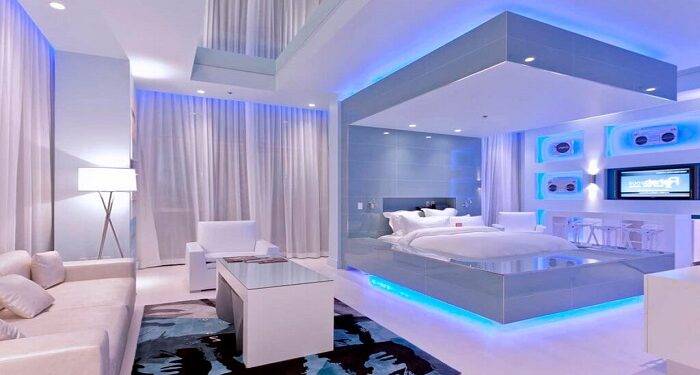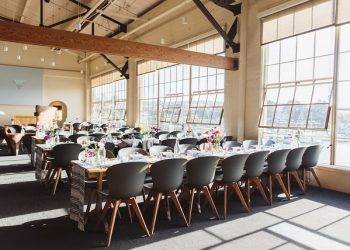The beauty of the interior and the comfort level of staying in the space largely depend on the lighting. You can simply install some lamps and not worry. But then there is a possibility that the room, even with a good repair, will be uncomfortable. The lighting design helps to place the lamps correctly. Any designer’s project begins precisely with the selection of lighting points and their capabilities. We will tell you what light design is, what lighting is like and how to choose the right lighting devices.
WHAT IS WORLD DESIGN
Lighting design is a system of distribution of lighting devices in space according to many criteria. The light must solve several tasks, among them functional, emotional and aesthetic. The lighting design allows for the correct distribution of devices so that the user is comfortable in the space, the lighting would be rational and profitable from the point of view of maintenance and emphasize the best parts of the interior.
Lighting design in the interior has the main task: to organize a comfortable space in which you will be comfortable. Therefore, any designer starts with lighting planning. In addition, there are certain rules and requirements of SNiP for the placement of lighting equipment. As a rule, a light audit is conducted. Many companies offer global electrical services, thanks to which the placement of electrical equipment will be not only comfortable, but also correct.
Interior lighting design includes an audit and is a necessary component of high-quality and safe renovation. With the help of lighting, not only the space is organized, but also the necessary atmosphere is created, details are emphasized, interior features stand out.
WHAT LIGHTING IS LIKE
It would seem that lighting can be different, but in fact, it has many parameters. We will not go into the theory of light, but we will talk about the main criteria. Light has two main parameters: color and brightness. There can be different shades, they depend on the light source itself. For example, an incandescent lamp has a yellow shade of light, while there are blue and violet rays. Therefore, if there are blue or green colors in the interior, the incandescent lamp will absorb them.
Artificial lighting should be close to the natural daytime light source. LED lamps help in this. They also have a wide range of parameters, but still much more pleasant and safer for the human eye. At the same time, the level of energy consumption is an order of magnitude lower than that of incandescent lamps. The efficiency of LED lamps is 6-8 times higher than that of incandescent lamps, but most importantly, they practically do not change the color of the interior and do not absorb the color.
Lighting has several types of streams and is used for different tasks. Here are the main ones:
- The light flux comes from a local point and is also directed to a certain point. Such lamps can include table LED lamps, sconces, floor lamps or track LED lamps.
- Diffused direct light. It covers a large part of the area, it is also called the main or background light. As a rule, these are large lamps in the center of the room, creating general lighting. This includes chandeliers, LED lamps, wall lamps. It is believed that every room should have at least one source of background diffused light.
- Decorative lighting. It is used to emphasize the elements of the interior or exterior and as a small additional illumination. These include LED lamps, flexible neon, small lamps, garden and park LED lamps.
Depending on the tasks, the necessary light source is selected. This is what lighting design is needed for.
HOW LIGHTING INFLUENCES THE EMOTIONAL STATE OF A PERSON
It is difficult to deny that lighting affects not only the appearance of the interior, but also the emotional state of a person. While conducting research, scientists concluded that lighting directly affects a person’s mood, emotional and physical health. Lighting can be both beneficial and harmful. Therefore, when developing a lighting design, it is worth considering several of the properties that lighting provides. Here are the main recommendations:
- Yellow light. It is good for the eyes, not oppressive, comfortable and pleasant. Creates an atmosphere of coziness and comfort. That is why only yellow lamps were used before. But it distorts the color of objects. However, you can use filament lamps with LEDs, or choose LED lamps with warm shades.
- White lighting increases efficiency. Have you noticed that bright white lighting is mostly installed in offices? All because this color is as close as possible to daytime. It concentrates, concentrates. But it also gets tiring quite quickly, so it should be placed only in spaces where concentration is required.
- Red lighting creates an atmosphere of intimacy, charges with cheerfulness and energy, but can even raise pressure. Therefore, it is recommended to use this type of lighting only in spaces where there is no need to focus and create coziness.
- Orange shades provoke an appetite, so today many establishments install filament LED lamps in the halls. And it also increases the heart rate, creating a slight excitement, which is why bright orange lamps are used in some trading rooms.
- Blue lighting maximally relaxes, reduces pressure and calms. Therefore, LED lamps of cold shades are often used in living rooms. The lighting is as if it were white, but at the same time the blue is created due to the cold glow.
- Green light has a positive effect on children, it is comfortable for the eyes. Therefore, it is recommended to install lamps or floor lamps that create a green glow in children’s rooms.
- Blue or violet light is used extremely rarely in residential premises. The whole point is that it acts annoyingly, tensely and depressingly. But at the same time it focuses and provokes quick reactions. Such lighting is not used in a space where you need to stay for a long time.
When developing a light design, it is necessary to take into account what color the lamps will be, and what kind of light will be created as a result. How comfortable staying in the space will depend on this.
BASIC RULES OF LIGHTING
For lighting to be as effective as possible, it is necessary to follow the basic rules for setting up lighting equipment. They help create a harmonious design and highlight important interior elements. In light design, the rules of staging are as follows:
- The lighting design must necessarily be combined with the main color of the interior and correspond to it. It can be in tune, complementing, or contrast. But all the colors of the lamps must correspond to the general design decision.
- The flow of light can visually stretch the room, creating elongated shapes. Therefore, it is worth considering the direction of light sources to create as large an area as possible.
- If there is enough natural lighting in the room, and the design itself is bright, then a uniform type of light is used. If the design is made in dark colors, it is necessary to illuminate each zone separately.
- If you create a working area, then you need to use white light, it has the best effect on productivity and concentration.
- If the interior items are of light shades, then they are illuminated with colored lighting, because ordinary white light will simply illuminate them. If bright details are used in the interior, it is better to use bright lighting that does not distort the color.
- There may be areas with little lighting in the room, but it is better to avoid saturated shadows and a complete lack of light.
- Using cold shades, you can achieve a visual expansion of the walls and an increase in the volume of the room.
Using these rules, the designer selects the required number of lighting sources, their appearance and lamp parameters. Correct lighting is the key to the overall quality of the interior and design.








